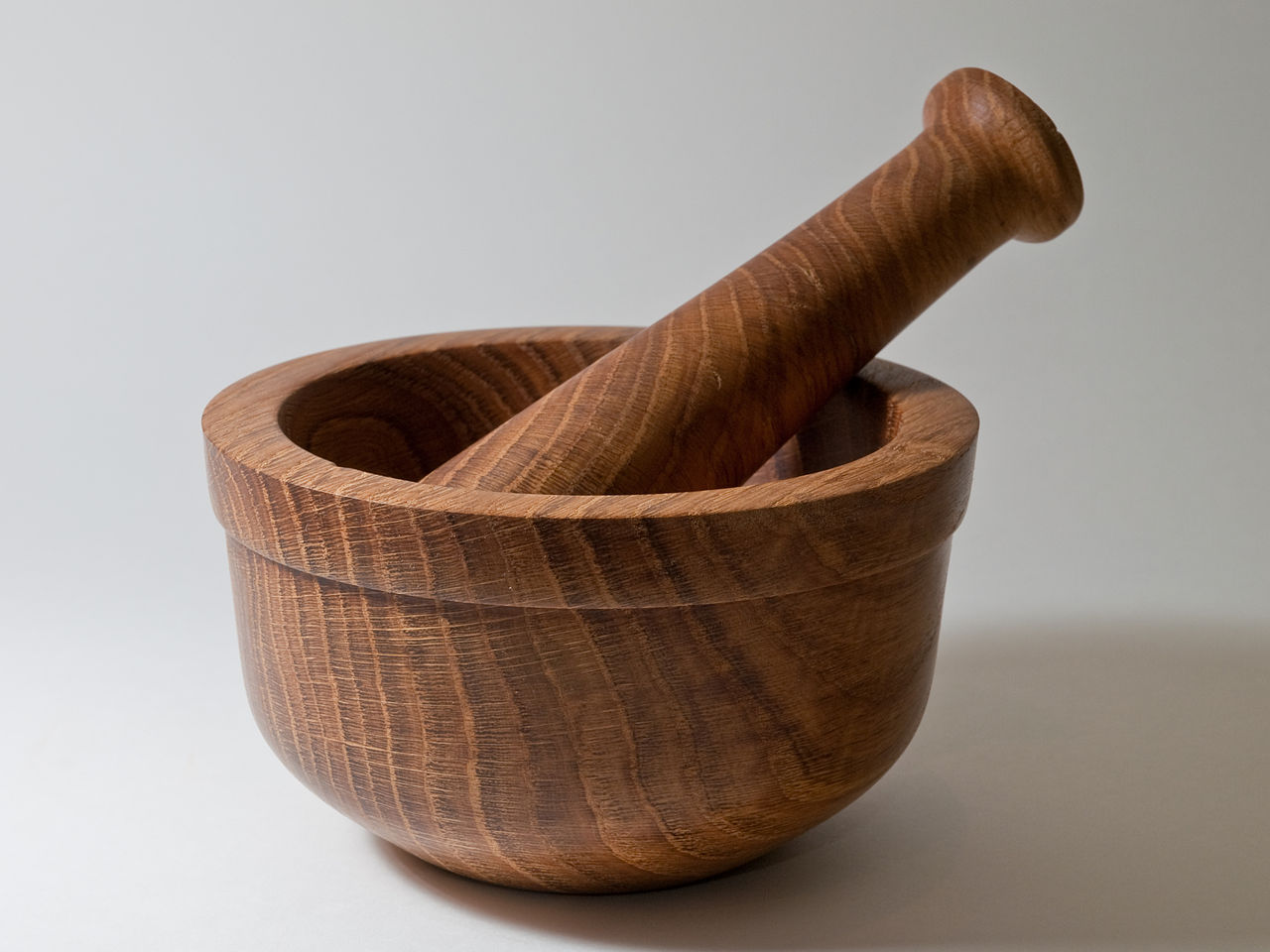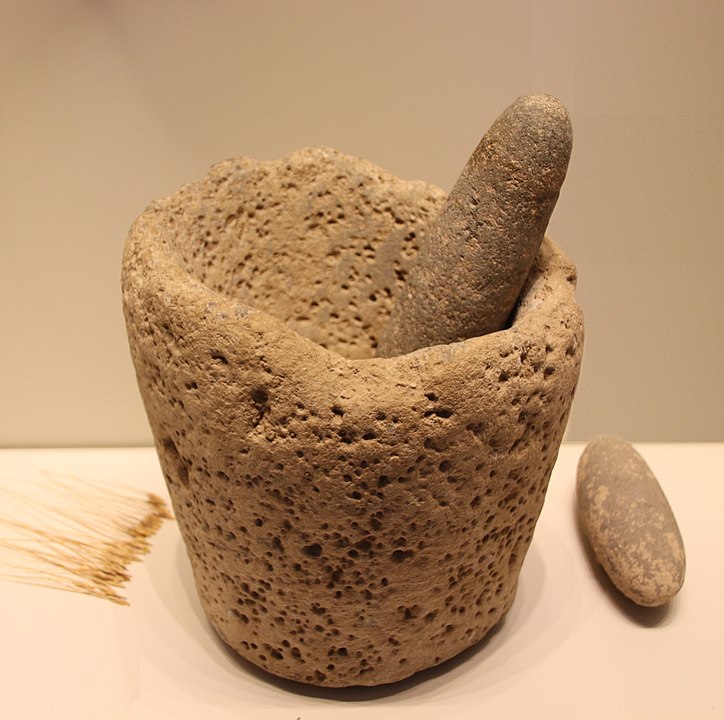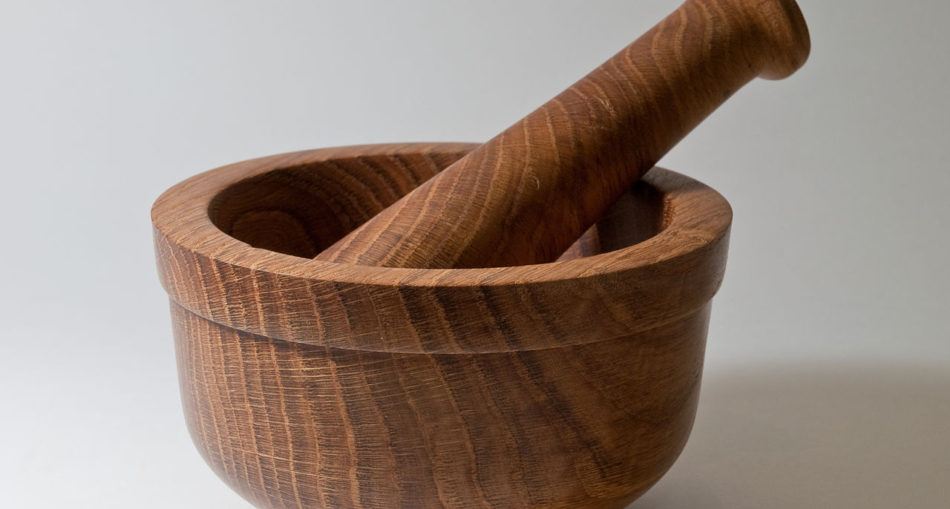The Mortar and Pestle are traditional grinding tools, similar in kind to the sil and lorha. Mortars and Pestles have existed since very early time, spread across the world and in different cultures. As such, there are many names for this pair. These include the Mexican molcajete y Tejolote, suribachi and surikogi, batu lesung. Cobek and tjobek are Netherlander and Indonesian names for the mortar while their pestles are called ulekan or oelekan.
Mortars and Pestles have a number of uses around the world. In Guyana, they are used to grind spices and to make a traditional, African dish; Foo- Foo . The skilful process of grinding brings out the oils, and flavourful essence of the substancee. In addition to their use in cooking, the Mortar and Pestle are used in medicine and are two of the most well-known symbols in medicine; specifically in pharmacology.

Wooden Mortar and Pestle – Photo By William Warby from London, England – Mortar and Pestle, CC BY 2.0, https://commons.wikimedia.org/w/index.php?curid=32313091
Origin of the Mortar and Pestle
It is difficult to ascertain where or at which point in time the Mortar and Pestle were invented since they exist in many cultures worldwide. Some scientists have discovered ancient versions of mortars and pestles in Southwest Asia dating back to about 35000 BC.
Interesting Tip
- The English words mortar and pestle are obtained from the Latin ‘mortarium’ and ‘pistillum’.
Description of the Mortar and Pestle
The Mortar is simply described as a bowl made of durable material to withstand heavy pounding. A Pestle can be best described as a club used to crush ingredients within the Mortar. Both the Mortar and Pestle can be made with a number of materials. These materials range from stone, marble or agate, wood, bamboo, iron, steel, brass, basalt and even glass. While the shape of the mortar is mostly constant, some may be flat. The sizes of mortars and pestles vary, depending on their use; for shucking grain, grinding pills or mincing herbs and spices.
Interesting Tip
- Granite mortars and pestles (sil and lorha) are especially popular in Pakistan and India and other parts of Southeast Asia.
- Chobeks resemble a deep saucer while the ulekan in ovoid.
Traditional Uses of the Mortar and Pestle
- Mortars are used in the preparation of wet and oil ingredients for food like hummus, guacamole and pesto.
- In Southeast Asia in countries like Pakistan and India, the mortars and pestle are used to grind and mix species for numerous dishes.
- Traditionally, turmeric/dye are ground for use in special Hindu ceremonies like weddings.
- People in Japan use very large mortars and wood pallets to prepare mochi, a Japanese rice cake.
- In West Asia, gigantic stone mortars with wooden pestles up to three (3) foot long were used to grind meat for kibbeh and masabcha.
- In Indonesia, these kitchen tools were used to make sambal and to grind peanuts for their famous peanut sauce.
- The wood of grapevines was used to make mortar and pestles, which were great for grinding salt and pepper.
- The Aztecs and the Mayans used molcajete, the Mexican traditional mortar and pestle which was made of basalt.
- Other Pre-Hispanic Mesoamerican and native Americans carved mortars into bedrock which they used to grind nuts like acorns.
- In Guyana, they are used to pound starchy ground provisions like plantains, cassava, malanga (eddo) or yam to prepare Foo-Foo, which is a traditional African dish.

Traditional Mortar and Pestle – Photo By Gary Todd – https://www.flickr.com/photos/101561334@N08/43166941322/, CC0, https://commons.wikimedia.org/w/index.php?curid=78718927
Uses of the Mortar and Pestle in Medicine
- Traditionally, ingredients were crushed when preparing prescriptions in pharmacies. For use in the pharmaceutical industry, the tip of the pestle is made with porcelain and the handle, with wood. This was named the Wedgwood mortar and pestle which originated sometime in 1759.
- Pills are ground for faster absorption with these two tools and then ingested.
- Mortars and pestles were also used to ground drugs which were not available in a liquid form.
- They were also used in insufflation, which means taking medicine through cavities like the nose.
About the Mortar and Pestle
Mortars and Pestles are among the most ancient and widespread kitchen tools. They are also famed for their use in medicine. The use of these traditional tools is decreasing with new inventions such as grinders powdered by electricity. Yet, nothing can compare to a good Foo-Foo or smell of fresh spices prepared with a Mortar and Pestle. These simple grind tools are easy to use and effectively extract the flavour from anything ground in them.
Article References
- http://snst-hu.lzu.edu.cn/zhangyi/ndata/Mortar_and_pestle.html
- https://www.britannica.com/technology/mortar-and-pestle
- https://cambridgeenviro.com/blogs/news/the-history-and-uses-of-the-mortar-and-pestle
- https://healthyliving.natureloc.com/mortar-pestle-history-explained/
- https://www.gourmetsleuth.com/articles/detail/mortar-and-pestle#:~:text=pottery%2C%20or%20stone.-,The%20pestle%20is%20a%20bat%20shaped%20tool%20that%20is%20used,by%20Apothecaries%20(ancient%20Pharmacists).
- https://www.finecooking.com/article/the-magic-of-the-mortar-and-pestle
Discover more from Things Guyana
Subscribe to get the latest posts sent to your email.







